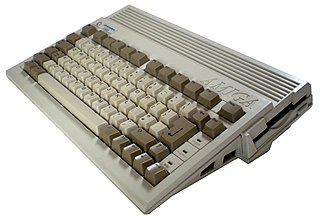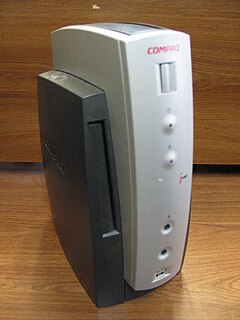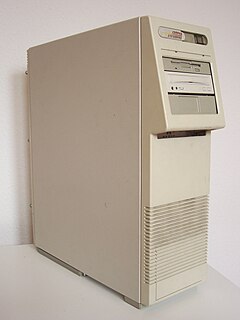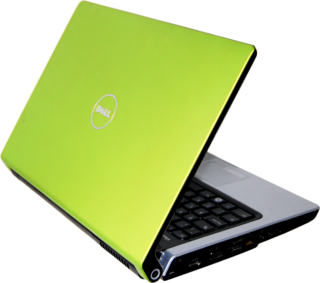
The PowerBook is a family of Macintosh laptop computers designed, manufactured and sold by Apple Computer, Inc. from 1991 to 2006. During its lifetime, the PowerBook went through several major revisions and redesigns, often being the first to incorporate features that would later become standard in competing laptops. The PowerBook line was targeted at the professional market, and received numerous awards, especially in the second half of its life, such as the 2001 Industrial Design Excellence Awards "Gold" status, and Engadget's 2005 "Laptop of the Year". In 1999, the line was supplemented by the home and education-focused iBook family.

The Amiga 600, also known as the A600, is a home computer introduced in March 1992. It is the final Amiga model based on the Motorola 68000 and the 1990 Amiga Enhanced Chip Set. A redesign of the Amiga 500 Plus, it adds the option of an internal hard disk drive and a PCMCIA port. Lacking a numeric keypad, the A600 is only slightly larger than an IBM PC keyboard and weighing approximately 6 pounds. It shipped with AmigaOS 2.0, which was considered more user-friendly than earlier versions of the operating system.
Kaypro Corporation was an American home and personal computer manufacturer based out of San Diego in the 1980s. The company was founded by Non-Linear Systems (NLS) to compete with the popular Osborne 1 portable microcomputer. Kaypro produced a line of rugged, "luggable" CP/M-based computers sold with an extensive software bundle which supplanted its competitors and quickly became one of the top-selling personal computer lines of the early 1980s.

The Power Macintosh G3 is a series of personal computers designed, manufactured, and sold by Apple Computer, Inc. from November 1997 to August 1999. It represented Apple's first step towards eliminating redundancy and complexity in the product line by replacing eight Power Macintosh models with three: Desktop and Mini Tower models for professional and home use, and an All-In-One model for education. The introduction of the Desktop and Mini Tower models coincided with Apple starting to sell build-to-order Macs directly from its web site in an online store, which was unusual for the time as Dell was the only major computer manufacturer doing this. Apple's move to build-to-order sales of the Power Macintosh G3 also coincided with the acquisition of Power Computing Corporation, which had been providing telephone sales of Macintosh clones for more than two years.
The Tandy 2000 is a personal computer introduced by Radio Shack in September 1983 based on the 8 MHz Intel 80186 microprocessor running MS-DOS. By comparison, the IBM PC XT used the older 4.77 MHz Intel 8088 processor, and the IBM PC AT would later use the newer 6 MHz Intel 80286. Due to the 16-bit-wide data bus and more efficient instruction decoding of the 80186, the Tandy 2000 ran significantly faster than other PC compatibles, and slightly faster than the PC AT. The Tandy 2000 was the company's first computer built around an Intel x86 series microprocessor; previous models used the Zilog Z80 and Motorola 6809 CPUs.

The FM Towns is a Japanese personal computer, built by Fujitsu from February 1989 to the summer of 1997. It started as a proprietary PC variant intended for multimedia applications and PC games, but later became more compatible with IBM PC compatibles. In 1993, the FM Towns Marty was released, a game console compatible with existing FM Towns games.

The PowerBook G3 is a series of laptop Macintosh personal computers designed, manufactured, and sold by Apple Computer, Inc. from 1997 to 2001. It was the first laptop to use the PowerPC G3 (PPC740/750) series of microprocessors, and was marketed as the fastest laptop in the world for its entire production run. The PowerBook G3 was succeeded by the PowerBook G4.

Compaq's first computers' form factors were portable, also called "luggables", and then "lunchbox computers", and together constituted the Compaq Portable series. These computers measured approximately 1 by 1 foot on the side, and were approximately 2+1⁄2 feet (0.76 m) wide. As the products evolved, laptops and notebooks were created offing a new level of portability that caused the market to explode.

A disk enclosure is a specialized casing designed to hold and power disk drives while providing a mechanism to allow them to communicate to one or more separate computers.

The iMac G3, originally released as the iMac, is a series of Macintosh personal computers developed by Apple under the tenure of Apple's interim CEO and cofounder Steve Jobs after his return to the financially troubled company.

The iPAQ Desktop Personal Computer in its various incarnations was a legacy-free PC produced by the Compaq Computer Corporation around the year 2000.

The Toshiba Satellite was a line of consumer-grade notebook computers marketed by Toshiba, and were some of the earliest laptops, introduced in the early-1990s, to compete with the IBM ThinkPad line. Models in the Satellite family varied greatly - from entry-level models sold at major retailers to full-fledged media center-class notebooks. The latter are labeled as "Qosmio" and sold alongside the Satellite name. The Qosmio models tended to have added features like two hard drive bays, multiple graphics cards, several input/output ports of varying design, unique case styling, backlit keyboards, significantly more powerful sound systems, etc. The Satellite mainly competes against computers such as Acer's Aspire, Dell's Inspiron and XPS, HP's Pavilion, Stream and Envy, Lenovo's IdeaPad and Samsung's Sens.

The Compaq Presario 1200 was a line of notebook computers produced between 1998 and 2000 by Compaq as part of Compaq Presario line. They were originally noted for their AMD processors, light weight and 12-inch LCD screens, while later models included a shift to Intel processors and other changed features. The label of "Compaq Presario 1200" includes a vast set of model numbers and revisions, many of which are not totally compatible, even though the machines share the same general Presario model number.

The SystemPro from Compaq, released in November 1989, was arguably the first true PC based server. It supported Intel's 486 chip, a 32-bit bus, RAID disk and dual-processor support well before its main rivals.

TravelMate is a series of business-oriented computer notebooks manufactured by Acer. Of the various notebook series Acer has offered, the TravelMate is designated as a lightweight business and professional computer built to withstand day-to-day activities. Travelmate laptops are well received by reviewers, often, however, they are faulted for a lack of visual appeal. The TravelMate name was previously used by Texas Instruments, which sold its mobile computing division to Acer in 1997. The TravelMate mainly competes against computers such as Dell's Latitude, HP's EliteBook and ProBook, Lenovo's ThinkPad and Toshiba's Portégé.

The history of laptops describes the efforts, begun in the 1970s, to build small, portable personal computers that combine the components, inputs, outputs and capabilities of a desktop computer in a small chassis.

Dell's Studio brand was a range of laptops and desktops targeted at the mainstream consumer market. The computers sit above Dell's Inspiron and below the XPS consumer lines in price and specifications. They differ from Dell's lower-end Inspiron models by offering slot-loading optical drives, media keys, more cover design options, faster processor options, HDMI and eSATA ports, LED-backlit screens and backlit keyboards.

HP Mini is a former line of small computers categorized as netbooks manufactured by Hewlett-Packard. They either contained a custom version of Ubuntu Linux, Microsoft Windows XP Home Edition or Windows 7 Starter operating system. Like most netbooks, they were not built with CD/DVD drives. However, HP did sell portable DVD-ROMs with HP's LightScribe disc imaging software. These netbooks are best used for written documents, small programs and web browsing. They can run standard software, but given their low price, they tend to have low end specifications, causing poor performance. They were announced from mid-2007, and marketed from 2008 through 2012.
The Dell 1764 is a laptop computer designed by Dell. At the time of its introduction, it was noted for a fast processor and good sound, a medium hard disk drive and a release price of 679 USD.

The Dell Inspiron series of laptop computers was introduced before 1999 as a consumer-oriented line, available to the general public through electronics and department stores, contrasting to the business/enterprise-oriented Dell Latitude series of laptop computers, and are usually ordered from Dell directly via the website, phone, or mail-order.


















